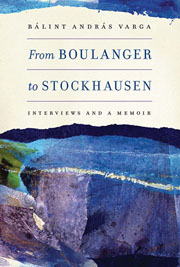Book contents
- Frontmatter
- Dedication
- Contents
- Foreword
- Acknowledgments
- Part One Interviews
- Preface to the Interviews
- Composers
- Conductors
- Ernest Bour
- Sir Neville Marriner
- Eugene Ormandy
- Hans Swarowsky
- Iván Fischer and Ádám Fischer
- Instrumentalists
- Singers and a Record Producer
- A Teacher
- Music Administrators
- Snippets
- Part Two A Memoir
- Notes in Retrospect
- Index
- Miscellaneous Endmatter
Eugene Ormandy
from Conductors
Published online by Cambridge University Press: 05 January 2014
- Frontmatter
- Dedication
- Contents
- Foreword
- Acknowledgments
- Part One Interviews
- Preface to the Interviews
- Composers
- Conductors
- Ernest Bour
- Sir Neville Marriner
- Eugene Ormandy
- Hans Swarowsky
- Iván Fischer and Ádám Fischer
- Instrumentalists
- Singers and a Record Producer
- A Teacher
- Music Administrators
- Snippets
- Part Two A Memoir
- Notes in Retrospect
- Index
- Miscellaneous Endmatter
Summary
In 1973, I was seconded jointly by Editio Musica Budapest and Hungarian Radio to accompany the Budapest Symphony Orchestra on its tour of the United States. My job was to send back weekly reports, and to write a book. My tape recorder gave the trip its special purpose. It acted as a magnet, so to speak, or as a compass, drawing and directing me toward potential interviewees.
In Philadelphia, where the orchestra appeared at the Academy, it led me backstage toward an old man of short stature with a familiar if rather masklike, immobile face. Eugene Ormandy was quite obviously tense, in something of an emotional turmoil. He had not heard a Hungarian orchestra since the late 1930s and apparently could not resist the temptation to go to hear it. Undecided about what to do, how to behave, he had stipulated that he wished to remain incognito. He need not have worried, for nobody recognized him. That, in turn, disappointed and possibly hurt him. He was of course welcomed by the conductor, György Lehel, and as for me, I did not for a moment hesitate to ask for an interview. I was tremendously thrilled to see him in person, having heard his recordings all my life and seen his face on record covers. In fact, Ormandy was something of a legend for me (together with other great American conductors of Hungarian birth, such as Fritz Reiner, George Szell, Georg Solti, or Antal Doráti).
- Type
- Chapter
- Information
- From Boulanger to StockhausenInterviews and a Memoir, pp. 89 - 98Publisher: Boydell & BrewerPrint publication year: 2013



